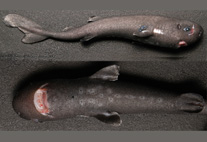Abstract
The marine nematodes usually comprise free-living species, although a few are parasitic. However, several cases of free-living nematodes found accidentally in the digestive tract of certain vertebrates, especially fishes, have sometimes been recorded and categorized as pseudoparasites. In the present work, two species of marine fishes, the rhomboid crappie, Diapterus rhombeus, and the silvered crappie, Eucinostomus argenteus (Perciformes: Gerreidae), from Angra dos Reis on the coast of Rio de Janeiro (Brazil) were examined. Seven species of free-living marine nematodes were found in the digestive tract of these fish. Several of these species remain unknown as free-living forms in Brazil. The combination of the fish feeding strategies and the poor preservation of the body of the nematode specimens found could indicate that these nematodes are pseudoparasites, appearing in the fishes’ digestive tracts through accidental ingestion and thereafter surviving for brief periods of time. Descriptions, illustrations and tables of measurements are provided for all species. Six of these species (Croconema torquens, Dorylaimopsis pellucida, Oncholaimellus labiatus, Parodontophora breviamphida, Prooncholaimus ornatus, Trissonchulus latus) have been reported for the first time from the Brazilian coast.

